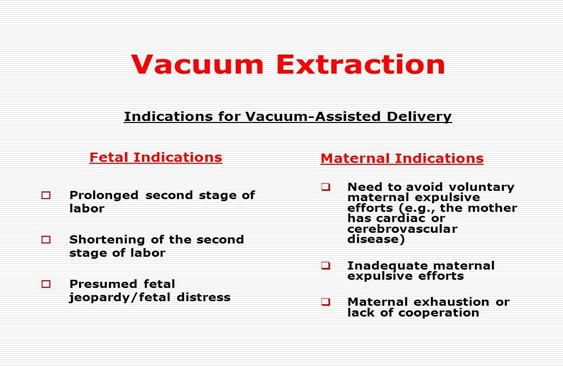The most common indication for a vacuum-assisted delivery is:
Prevention of fetal abnormalities.
Prevention of maternal hemorrhage.
Prolonged second stage of labor.
Prolonged first stage of labor.
The Correct Answer is C
The most common indication for a vacuum-assisted delivery is a prolonged second stage of labor, which means that the mother has been pushing for an extended period without effective descent of the fetal head. The vacuum can help to provide traction to the fetal head and assist with delivery.
Option A is incorrect because a vacuum-assisted delivery is not indicated for the prevention of fetal abnormalities.
Option B is incorrect because a vacuum-assisted delivery is not indicated for the prevention of maternal hemorrhage.
Option D is incorrect because a prolonged first stage of labor is not an indication of
vacuum-assisted delivery. In this case, other interventions, such as augmentation of labor with oxytocin, may be used.

Nursing Test Bank
Naxlex Comprehensive Predictor Exams
Related Questions
Correct Answer is A
Explanation
Assessing fetal heart rate (FHR) and maternal vital signs would be the highest priority nursing intervention when admitting a pregnant woman who has experienced a bleeding episode in late pregnancy. This is because fetal distress or maternal instability may require immediate medical intervention, such as delivery via emergency cesarean section or blood transfusions, respectively.
Therefore, assessing the FHR and maternal vital signs will help to determine the urgency of the situation and guide the next steps in the management of the patient. Once the patient's condition has stabilized, performing venipuncture for hemoglobin and hematocrit levels, monitoring uterine contractions, and placing clean disposable pads to collect any drainage can be done as appropriate.
Correct Answer is C
Explanation
Infants of diabetic mothers (IDM) are at risk of hypoglycemia because they have been exposed to high levels of glucose in utero. The fetus responds to this high glucose level by producing high levels of insulin to regulate the glucose level. After delivery, the glucose supply from the mother is cut off and the infant's insulin levels remain high, leading to hypoglycemia.
Additionally, the infant's ability to produce glucose is immature and may not be sufficient to maintain normal blood glucose levels, especially if the infant is premature or small for gestational age. Therefore, IDM requires close monitoring of their blood glucose levels to prevent and treat hypoglycemia.
Whether you are a student looking to ace your exams or a practicing nurse seeking to enhance your expertise , our nursing education contents will empower you with the confidence and competence to make a difference in the lives of patients and become a respected leader in the healthcare field.
Visit Naxlex, invest in your future and unlock endless possibilities with our unparalleled nursing education contents today
Report Wrong Answer on the Current Question
Do you disagree with the answer? If yes, what is your expected answer? Explain.
Kindly be descriptive with the issue you are facing.
